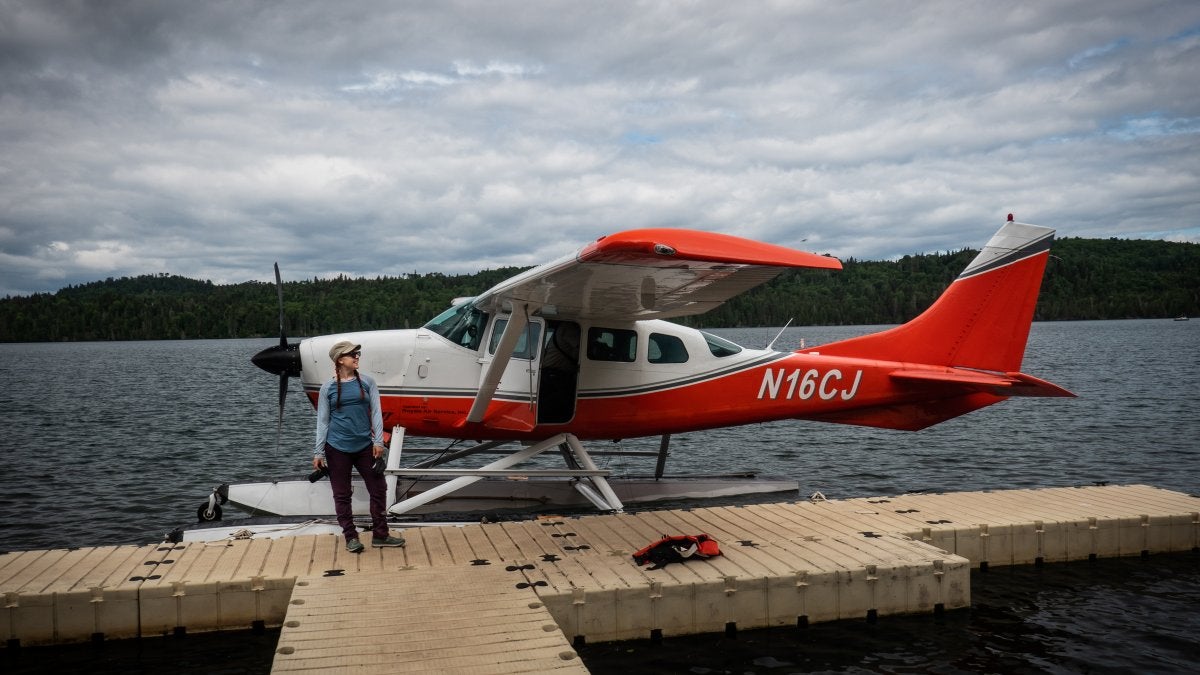No products in the cart.
Outdoor Adventure
Isle Royale National Park Is as Wild as it Gets
62 Parks Traveler started with a simple goal: to visit every U.S. national park. Avid backpacker and public-lands nerd Emily Pennington saved up, built out a tiny van to travel and live in, and hit the road. The parks as we know them are rapidly changing, and she wanted to see them before it’s too late.
Pennington is committed to following CDC guidelines during the COVID-19 pandemic to ensure the safety of herself and others. She’s visiting new parks while closely adhering to best safety practices.
From the moment my floatplane’s skis touched down on the deep blue waters of Lake Superior, I knew Isle Royale would be different. With normal tour-boat operations suspended for the 2020 season, the only way to reach this remote archipelago in northwestern Michigan was by seaplane, transforming the least visited national park in the lower 48 into a ghost town for serious backpackers and hikers. It felt like landing in Jurassic Park.
As home to nearly 2,000 moose, 14 wolves, and a diverse tapestry of boreal and northern-hardwood forests, Isle Royale is about as wild as a place can get. With no roads, no cars, and limited facilities, it is an ideal spot for a multi-day trip to revel in the quietude of an undeveloped park. So my partner, Brian, and I set off to backpack the 42-mile Greenstone Ridge Trail.
The trail was tough. With July temperatures hovering around 80 degrees, plus 74 percent humidity, slogging my 35-pound pack up and down a series of buggy, tree-covered slopes left me gasping for breath. Starting on the more forested Windigo side of the island meant there were few views to be had on our first two days of hiking. Apart from a moose carcass and a trail overgrown with bracken ferns, there was little to see.

But then, on the second night, something remarkable happened. While camped at the water’s edge of West Chickenbone Lake, a horseshoe-shaped inland tarn, I heard a splash. I grabbed my camera and rushed outside my tent in the dazzling orange light of sunset. “Is it a moose?” I whispered to Brian, craning my neck to get a better view through the dense trees.
Sure enough, a young bull moose was swimming our way, his enormous furry body just 200 feet from camp. He must have heard my whispers, because as he neared our shoreline perch, he stood up out of the water, a full seven feet tall, and stared directly at me, curious. My jaw dropped, and my heart flew into my throat. The animal was enormous. Lucky for us, he quickly assumed we weren’t a threat and immediately went back to sauntering across the lake. I was beginning to like this place.
At the end of day three, I descended from the ridgeline after stuffing my face with plump wild blueberries and veered onto the Rock Harbor Trail. The terrain was becoming rockier now, with paper birch and spruce trees replacing the canopy of sugar maples and yellow birch.
From my vantage point on the lichen-encrusted shore, Lake Superior looked like a vast freshwater ocean. By comparison, I felt impossibly small and mortal as I made my way to Three Mile Campground, with its wooden structure, a picnic table, and view of the watery expanse. With rain in the forecast, I was excited to finally try sleeping in one of the park’s many hiking shelters, a spartan wooden shack with a screen on the lakefront side to ward off mosquitoes. Bumblebees punctuated the air with frenetic noises, flower-hopping from colorful bloom to colorful bloom.
The highlight of the trip came on the last day. When the morning rain stopped, Brian and I packed up our things and made our way along the southeastern edge of Isle Royale, climbing over huge boulders dotted with bright orange tiger lilies on the way to Scoville Point. I wanted to reach out and touch the very tip of this rugged wilderness, to stand with abandon at what felt like the edge of the known world.
When I got to the very end of the trail, I gazed off into the clouds, embracing the liminal space, at home in the dirt and the wind.
62 Parks Traveler Isle Royale Info
Size: 571,790 acres
Location: Northwestern Michigan
Created In: 1940 (national park)
Best For: Backpacking, hiking, boating, fishing, stargazing
When to Go: Isle Royale is one of the few parks that is fully closed in the winter (November 1 to April 15). Ferries typically start running in early May. While summer (46 to 81 degrees) is the most popular time to visit, spring (26 to 58 degrees) and autumn (33 to 63 degrees) have cooler temperatures and fewer crowds.
Where to Stay: The Mangy Moose Motel in Grand Marais, Minnesota, is a fantastic jumping-off point for those awaiting a seaplane or ferry (or for tired backpackers ready for some R&R). Family owned and operated, this affordable inn has a funky canoe-themed decor, clean rooms, and the softest beds in town. For those looking to camp, sites are first-come, first-served, and permits are available upon landing.
Mini Adventure: Hike to Scoville Point. If you only have one day in the park, head to the Rock Harbor area and hop onto the 4.2-mile trail to Scoville Point. Hikers here will get to learn about the unique history, flora, and fauna of the region while traversing a loop along the coast of Lake Superior and through dense woodlands of spruce and fir.
Mega Adventure: Go on a backpacking trip. Though the Greenstone Ridge Trail is the celebrity of the park, I’m convinced that hikers could create their own, equally fun one-to-two-night trek by starting in Rock Harbor and looping up over Mount Ojibway if they’re short on time.
Lead Photo: Emily Pennington

